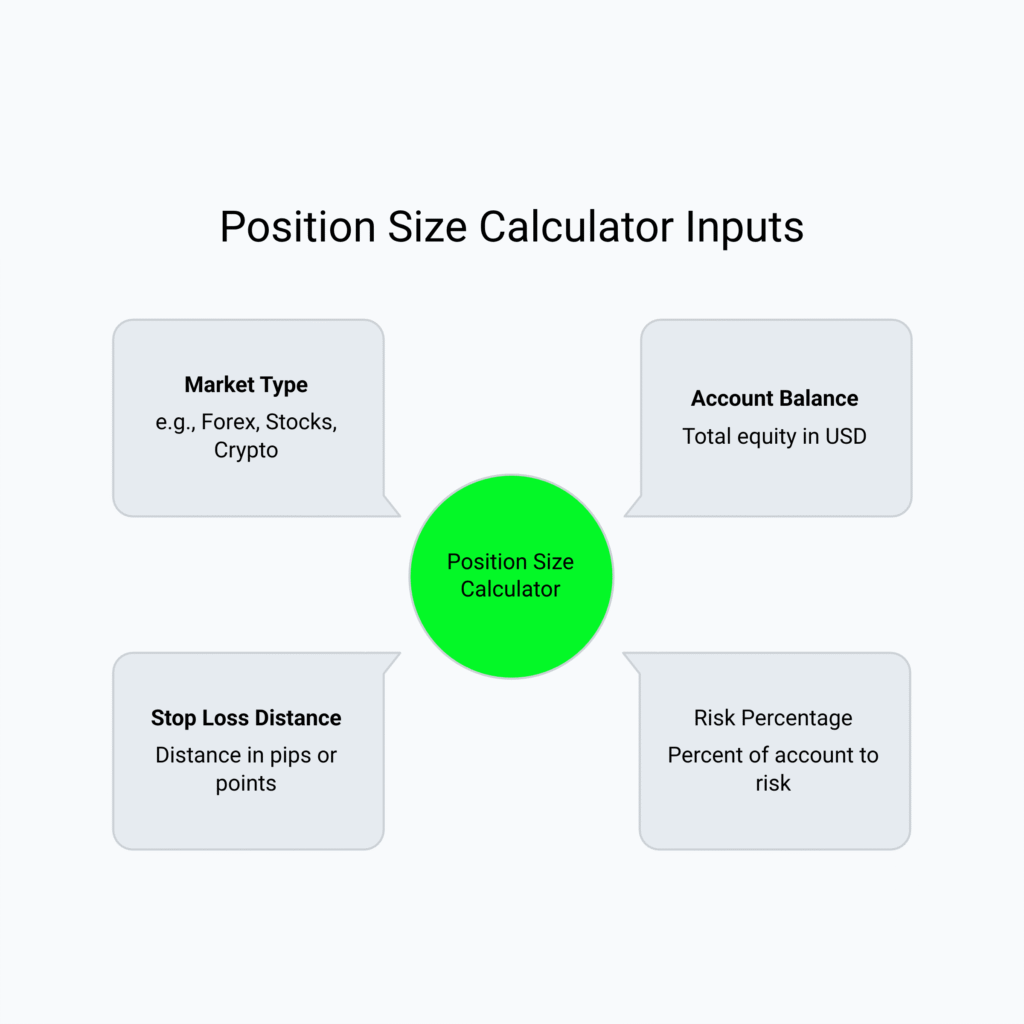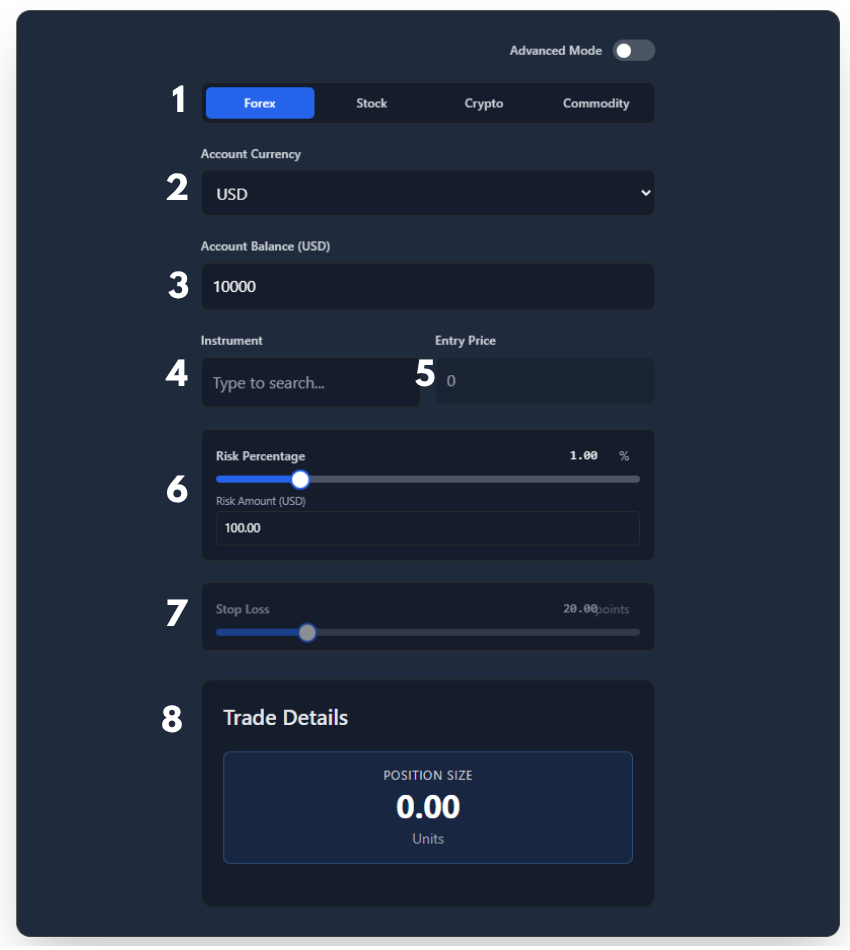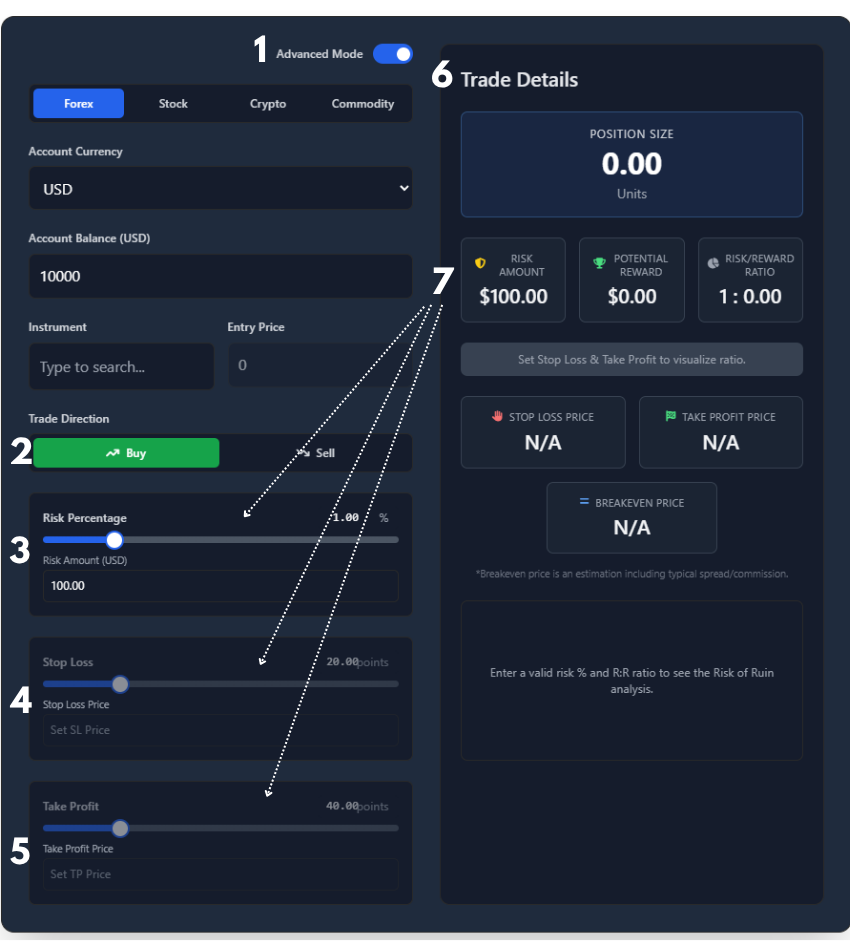Want to know exactly how much to risk on your next trade?
Use the position size calculator below. It’s the same one I use to eliminate the guesswork so I can focus on execution rather than math.
It works across forex, stocks, crypto, and commodities. For more control, switch on Advanced mode and watch the magic happen.
Most traders chase the “perfect” strategy. However, the truth is that the proper use of a position size calculator will determine whether your account grows or blows up.
The best trading strategy in the world doesn’t matter if you’re risking 10% of your account balance.
In today’s blog post, I’ll show you, step by step, how proper position sizing can elevate your trading. I’ll discuss how to use the calculator above, the ideal position size, and much more.
Let’s get started!
What Is a Position Size Calculator (and Why It Matters for Risk Management)
A position size calculator is your trading safety net. It helps you determine the optimal trade size based on your account currency, stop-loss level, and risk tolerance.
You type in a few simple details, such as your account balance, account currency, the amount you’re willing to risk on a single trade, and the distance your stop-loss price is from your entry price. It then does the risk calculation for you.
That’s it. No guessing, and no confusing indicators.
The Core Inputs You Need for Accurate Position Sizing
Every position size calculator runs on a few essential details. Here’s what to plug in:
- Account balance – your total equity, the base for every position sizing decision.
- Risk percentage – how much of that balance you’re comfortable risking on one trade. I recommend keeping this as close to 1% as possible, but never higher than 2%. The more conservative, the better.
- Stop loss distance – how far your stop loss level is from your entry price.
- Market type – because the value of a pip or tick changes depending on whether you’re trading forex, crypto, or other asset classes.

Real-world scenario:
You have a $10,000 account. You risk 1% ($100), and your stop loss level is 50 pips. The calculator will determine the number of micro, mini, or standard lots to trade in your selected currency pair.
If you’re trading Bitcoin, the calculator will output how much BTC you can buy based on the figures you input.
Simple. You instantly know your optimal size, regardless of whether you’re trading forex, stocks, crypto, or commodities.
No more guesswork. No more “feeling it out.” Just proper risk management.
How to Use a Position Size Calculator for Better Risk Management
The calculator above lets you toggle between simple and advanced settings.
Here are the step-by-step instructions:
Simple View

- Choose the market (forex, stocks, crypto, or commodities)
- Select your account currency. Example: If you live in the US, you’d choose USD.
- Enter your account balance. Use the real balance in your trading account, not the number you wish you had. That’s your account equity.
- Start typing the instrument. For forex, you can search for “EUR”, “GBP”, or any other currency pair. The tool will automatically complete what you start typing.
- Add an entry price. This is especially important for non-USD currency pairs.
- Set your risk percentage with the slider or type it in the box. This is the total percentage you’re risking based on your account balance. Keep it small.
- Set your stop loss distance. At what level is the trade invalidated? That’s where your stop goes. The more distance between your entry and stop, the smaller the position size.
- Get the Trade Details. You’ll see position size in units. That tells you how many units to trade. In forex, many brokers show mini or micro lots, which are also supported by this calculator.
- Round down. Then place the order with your broker.
Pro tip: Your size should change as the stop changes, not as your confidence changes. That protects the risks to your account balance.
Advanced Mode

- Turn on Advanced Mode at the top.
- Select ‘Buy’ or ‘Sell’ so the calculator knows your direction.
- Enter your account currency and account balance again if needed. Maintain the same risk percentage for every trade.
- Set your stop loss with the slider, then click to set the stop loss price. Now the panel displays your exact risk amount and break‑even estimate.
- Set a take profit with the slider or enter it manually. The risk/reward ratio will adjust as you make changes.
- Check the Trade Details. You’ll see the position size, which indicates the number of units to trade, as well as the ideal position size for your setup.
- If the size isn’t right, adjust the sliders. The goal is to get a position size that fits your rules and market conditions.
- Once everything checks out, you’re ready to place the trade.
Pro tip: Use the same settings on every trade. Consistency builds confidence.
Why the Perfect Position Size Beats the Perfect Strategy (and How Reward Ratio Fits In)
You can have the perfect entry price: tight levels, strong confluence, excellent technical analysis.
But if your risk management is off, one bad trade can wipe out weeks of progress.
I prioritize risk over reward for that reason. I also risk just 0.3-0.5% of my balance per trade, sometimes less if conditions aren’t ideal.
That limited risk per trade is part of my trading edge.
I wouldn’t be profitable if I were risking 5% of my account on every trade. The stress of that alone would take its toll in more than one way.
Position sizing is what keeps your trading account safe. It prevents one bad decision from causing serious damage.
Because here’s the deal:
Trading successfully isn’t about being right every time. It’s about protecting your capital, keeping losses small, and giving yourself more chances to catch solid setups.
Pro tip: Think of your risk per trade as the rent you pay for a chance to profit. The lower your rent, the longer you’ll last, and the more chances you’ll have to grow your account.
The Basic Logic Behind Position Size Calculation
The tighter your stop loss, the larger your trade size can be, as long as your total risk amount stays the same.
However, don’t suffocate the trade with a tight stop to increase size. That’s a recipe for disaster.
On the other hand, a wider stop loss requires a smaller position size. That’s true for every asset class if you want to manage risk effectively.
Example: If you risk $100 on a 50-pip stop, your trade size is double what it would be on a 100-pip stop, resulting in the same total risk but different exposure.
Pro tip: Always start with your stop loss set, not your lot size. The calculator works backward from there.
Examples Across Different Asset Classes
Forex Example
You’re trading EURUSD with a $5,000 account. You risk $100 (2%) with a 40-pip stop-loss level. The calculator tells you how many mini lots are equivalent to that $100 risk.
Crypto Example
You’re buying Bitcoin at $123,000 with a $1,000 account, risking 1%, and your stop loss price is $500 away. That’s a $10 risk, which equals about 0.02 BTC.
Stock Example
Apple is trading at $250. You have a $10,000 account and want to risk $100 (1%). You’re stop loss is $5 away from your entry, so the calculator determines you can buy 20 shares.
Commodity Example
Trading gold (XAUUSD) with a $20 stop loss level and a $10,000 balance, risking 1%. The calculator determines how many ounces fit your $100 risk.
Different asset classes, same logic.
Adjustments for Real Life Trading
Markets move fast, and slippage happens.
When in doubt, round your position size down to the nearest whole number.
That cushion keeps you within your risk tolerance, even if your required margin changes due to volatility.
Large position sizes make it nearly impossible to hold onto winning trades. If you want to hold winners longer, size down.
For example, if you calculate a 0.22 standard lot position (22,000 units), round down to 0.20 lots.
That 0.02 lot difference is your buffer for an unfavorable spread or slippage.
Always double-check your trade details before hitting that buy or sell button. Once you’re in a position, emotions can take over.
Pro tip: Always double-check your order (including trade details, direction, and stop loss) before entering the market.
Common Risk Management Mistakes to Avoid
- Guessing your position size instead of using a calculator
This one should be obvious by now, but let the calculator do the heavy lifting and help take some emotion out of your trading.
- Risking more after a loss to make it back
Do the opposite. Risk less after each loss and only increase it back to your original size once you’re winning. Survival is the name of the game.
- Ignoring differences in base currency or pip value
The calculator above takes care of this for you, as you can’t receive an output without entering your entry price.
- Forgetting to adjust your account balance after losing
You wouldn’t forget to increase your balance after a win, so don’t forget to do so after a loss, when it’s even more critical.
Remember that capital preservation is rule #1, and avoiding the mistakes above is crucial.
Conclusion: Keep Risk Management at the Core
Position sizing isn’t the exciting part of trading, but it’s the backbone of consistent performance.
When you get this right, your drawdowns shrink, your confidence grows, and your account balance starts to rise steadily.
So before your next trade, open the position size calculator above and enter your setup details. I promise you’ll trade with more confidence and less emotion.
The goal isn’t how much you make on one trade. It’s about how much you retain and how well you manage risk over the long term.
What’s your risk percentage per trade right now?
Frequently Asked Questions
What exactly is a position size calculator?
It’s a simple tool that shows how big your trade should be. It uses your account size, how much you’re willing to risk, and your stop-loss distance. Bottom line: The position size calculator eliminates the guesswork from risk management.
Do I need to use a position size calculator for every trade?
You should. Recalculating each setup maintains your risk level and ensures consistent results. Guessing is how traders blow accounts.
Can I use a position size calculator for stocks, cryptocurrencies, or indices, not just forex?
Yes. The logic stays the same across markets. Just plug in the right “pip value” or “units per point” for that asset class.
What happens if I move my stop-loss mid-trade?
It depends. Are you moving your stop closer to or further away from your entry? If closer, you’re good. If further away, you could take a bigger loss, and you’re probably breaking your risk management rules.
What’s the difference between lot size and position size?
Lot size is measured in units, such as one lot or 0.10 lot. Position size is how many of those units you’re trading based on your risk plan. The first is measure; the second is decision.



